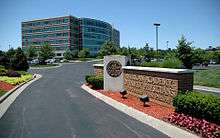American Academy of Family Physicians
The American Academy of Family Physicians (AAFP) was founded in 1947 to promote and maintain high quality standards for family doctors who are providing continuing comprehensive health care to the public. It is one of the largest medical organizations in the United States, with 134,600 members in 50 states, D.C., Puerto Rico, the Virgin Islands, and Guam, as well as internationally. The AAFP was instrumental in establishing family medicine - a derivative of classical general practice - as medicine's 20th primary specialty. The AMA's Council on Medical Education and the independent American Board of Medical Specialties granted approval to a certifying board in family medicine on February 8, 1969. The AAFP is headquartered in Leawood, Kansas.
.png) | |
| Formation | 1947 |
|---|---|
| Type | Professional association |
| Headquarters | Leawood, Kansas |
| Location | |
Membership | 134,600 |
Official language | English |
President | Gary L. LeRoy, MD, FAAFP |
Key people | President-Elect Ada D. Stewart, MD, FAAFP and Board Chair John S. Cullen, MD, FAAFP |
Staff | 415 |
| Website | aafp.org |

Mission
The mission of the AAFP is to improve the health of patients, families and communities by serving the needs of members with professionalism and creativity.[1]
Strategic Objectives
To fulfill its mission, the AAFP's strategic objectives include:
- Support and sustain comprehensive family medicine practices by advocating for models of payment reform that result in greater investment in family medicine.
- Reduce administrative complexity by reducing point-of-care administrative functions that detract from patient care activities, or do not add value.
- Equip members with clinical expertise to improve individual and population health by providing broad scope, personalized learning opportunities for members and other learners through relevant educational venues and formats.
- Grow a diverse family physician workforce by raising awareness around the importance of family medicine.
The AAFP also provides patients with free educational resources on its consumer health site.[2]
Structure
The AAFP is governed by a Congress of Delegates composed of two delegates from each of its 55 constituent chapters, as well as from resident and student groups, new physicians, and the special constituencies (women, minorities, international medical graduates, and LGBTQs). The Congress meets annually immediately prior to the Academy's Family Medicine Experience (FMX) event (formerly known as Scientific Assembly) and has sole power to establish policies and define principles. These policies are carried out between annual meetings by the Board of Directors and a number of standing and special commissions and committees. Delegates to the Congress of Delegates elect the Board, which in turn appoints commission and committee members. Constituent chapters are organized similarly.[3]
Publications
- AAFP News[4] - the official news publication of the American Academy of Family Physicians
- American Family Physician - an editorially independent official peer-reviewed, clinical review medical journal for physicians and other health care professionals.
- Family Practice Management[5] - a peer-reviewed, practice improvement journal dedicated to offering practical ideas for better practice, better patient care, and a better work life for family physicians.
- Annals of Family Medicine - a collaborative effort with six family medicine organizations
See also
References
- "Vision & Strategic Plan". aafp.org.
- "familydoctor.org". Archived from the original on 2007-07-05. Retrieved 2007-07-05.
- "About us". aafp.org.
- "AAFP News". www.aafp.org.
- "FPM". www.aafp.org/journals/fpm.html.
External links
- Official website
- American Family Physician - a journal by the AAFP
- Family Practice Management - a journal by the AAFP
- Annals of Family Medicine - a collaborative journal of the six family medicine organizations
- familydoctor.org - The AAFP's patient education site. Includes handouts, brochures, flowcharts and other resources for patients